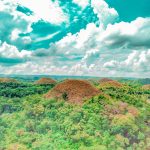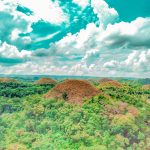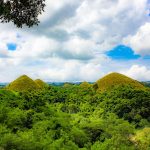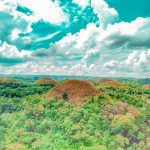Download links
How to install The Mysterious Beauty of Chocolate Hills APK?
1. Tap the downloaded The Mysterious Beauty of Chocolate Hills APK file.
2. Touch install.
3. Follow the steps on the screen.
Description
The Chocolate Hills, a geological marvel located in the Bohol province of the Philippines, are a striking natural formation that has captivated both scientists and tourists alike. These hills, numbering over 1,200, rise dramatically from the surrounding landscape, creating a surreal panorama that resembles a sea of chocolate mounds. The origin of these hills is attributed to a combination of geological processes, primarily limestone erosion and the uplift of coral deposits.
Formed during the Pleistocene epoch, the hills are believed to have been shaped by the dissolution of limestone by rainwater, which gradually eroded the softer rock layers, leaving behind the distinctive conical shapes that we see today. The unique topography of the region is further enhanced by the seasonal changes in vegetation. During the dry season, the grass that covers the hills turns a rich brown hue, giving them their name.
This transformation is not merely aesthetic; it plays a crucial role in the local ecosystem. The hills are composed of limestone, which is rich in calcium carbonate, and this geological composition contributes to the fertility of the surrounding soil. The interplay between geological processes and climatic conditions has resulted in a landscape that is not only visually stunning but also ecologically significant.
Key Takeaways
- Chocolate Hills are a geological formation in the Philippines, consisting of at least 1,260 individual mounds.
- The unique flora and fauna of Chocolate Hills include various species of plants, birds, and mammals, some of which are endemic to the area.
- Chocolate Hills hold cultural significance to the local community, with legends and folklore surrounding their formation.
- The geographical and geological wonders of Chocolate Hills are a result of limestone weathering and erosion over millions of years.
- Tourism and conservation efforts in Chocolate Hills aim to preserve the natural beauty and biodiversity of the area, while also promoting sustainable tourism.
The Unique Flora and Fauna of Chocolate Hills
Plant Species and Habitat
The region is home to a diverse array of plant species, many of which are found only in this area. Grasses dominate the landscape, but there are also patches of shrubs and trees that provide habitat for various animal species.
Wildlife and Unique Creatures
The hills serve as a crucial habitat for several bird species, including the Philippine tarsier, one of the smallest primates in the world. This nocturnal creature is known for its large eyes and unique ability to rotate its head almost 180 degrees, making it an intriguing subject for wildlife enthusiasts and researchers alike. In addition to birds and tarsiers, the Chocolate Hills support a range of other wildlife, including reptiles and insects.
Microclimates and Ecological Diversity
The unique microclimates created by the hills contribute to a diverse ecosystem where different species can thrive. For instance, certain areas may be more humid or shaded than others, allowing for variations in plant growth and animal habitation. This ecological diversity not only enriches the local environment but also provides opportunities for scientific research and conservation efforts aimed at preserving these unique habitats.
The Cultural Significance of Chocolate Hills to the Local Community
The Chocolate Hills hold profound cultural significance for the local communities in Bohol. They are not merely a natural wonder; they are woven into the fabric of local folklore and traditions. For many residents, these hills symbolize resilience and beauty, serving as a source of pride for the people of Bohol.
The hills are often featured in local art, literature, and festivals, reflecting their importance in the cultural identity of the region. Moreover, the Chocolate Hills have become a focal point for community gatherings and celebrations. Local festivals often incorporate elements inspired by the hills, showcasing traditional music, dance, and crafts that highlight Boholano culture.
These events not only foster community spirit but also attract visitors who wish to experience the rich cultural heritage of Bohol. The hills thus serve as a bridge between nature and culture, reinforcing the connection between the land and its people.
The Geographical and Geological Wonders of Chocolate Hills
| Aspect | Details |
|---|---|
| Location | Bohol, Philippines |
| Number of hills | 1,268 |
| Height of hills | 30 to 50 meters |
| Formation | Limestone and grass-covered karst cones |
| Geological age | Estimated 1.2 million years old |
| Color | Turn brown during dry season, hence the name “Chocolate Hills” |
Geographically, the Chocolate Hills are situated in a region characterized by rolling terrain and limestone formations. Their unique conical shapes are not only visually striking but also serve as an excellent example of karst topography. This type of landscape is formed through the dissolution of soluble rocks such as limestone, gypsum, or salt, leading to features like sinkholes, caves, and underground rivers.
The Chocolate Hills exemplify this process on a grand scale, showcasing how natural forces can sculpt the earth over millennia. Geologically, these hills provide valuable insights into the history of the Earth’s crust in this region. The presence of marine fossils within some of the limestone deposits indicates that this area was once submerged under water.
As tectonic activity uplifted these seabeds, they transformed into the rolling hills we see today. This geological history is not only fascinating for geologists but also serves as an educational resource for visitors interested in understanding Earth’s dynamic processes. The Chocolate Hills stand as a testament to nature’s ability to create breathtaking landscapes through time and change.
The Tourism and Conservation Efforts in Chocolate Hills
Tourism has become an integral part of the economy surrounding the Chocolate Hills, drawing thousands of visitors each year who come to marvel at their beauty. The Philippine government has recognized this potential and has implemented various initiatives to promote sustainable tourism in the area. Infrastructure improvements such as viewing platforms, walking trails, and visitor centers have been developed to enhance the tourist experience while minimizing environmental impact.
These efforts aim to balance economic benefits with ecological preservation. Conservation initiatives are equally important in ensuring that this natural wonder remains intact for future generations. Local organizations and government agencies work together to monitor environmental changes and promote responsible tourism practices.
By fostering a sense of stewardship among tourists and residents alike, these efforts help protect the delicate ecosystems surrounding the Chocolate Hills while allowing people to appreciate their beauty responsibly.
The Legend and Folklore Surrounding Chocolate Hills
The Battle of the Giants
One popular tale tells of two giants who engaged in a fierce battle over a beautiful maiden. In their rage, they hurled boulders at each other until they grew tired and eventually made peace. The remnants of their battle transformed into the hills we see today—mounds left behind from their quarrel. This story not only explains the hills’ unusual shapes but also reflects themes of conflict and resolution that resonate deeply within Filipino culture.
A Giant’s Love and Loss
Another legend speaks of a giant named Arogo who fell in love with a mortal woman named Aloya. When Aloya passed away, Arogo was heartbroken and wept for her loss. His tears formed into hills as they fell to the ground, creating what we now know as the Chocolate Hills. This poignant tale highlights themes of love and loss while illustrating how natural phenomena can be intertwined with human emotions and experiences.
A Rich Cultural Tapestry
Such folklore enriches the cultural tapestry surrounding the Chocolate Hills, making them not just a geological wonder but also a symbol of love, conflict, and reconciliation within Boholano heritage. The stories surrounding the Chocolate Hills serve as a reminder that nature is often intertwined with human experience, providing depth to our understanding of these remarkable formations. As visitors explore this breathtaking landscape, they are not only witnessing a natural wonder but also engaging with a rich cultural narrative that has been passed down through generations.
If you’re looking for a unique travel destination, consider visiting the Chocolate Hills in the Philippines. These iconic hills are a natural wonder and a must-see for any nature lover. For more information on travel apps that can enhance your trip, check out this article on Brainly: The Homework App.
FAQs
What are the Chocolate Hills?
The Chocolate Hills are a geological formation located in the Bohol province of the Philippines. They are made up of around 1,200 to 1,776 conical limestone hills, which are covered in green grass that turns brown during the dry season, giving them a chocolate-like appearance.
How were the Chocolate Hills formed?
The exact formation process of the Chocolate Hills is still a subject of debate among geologists. One theory suggests that they are the weathered formations of a marine limestone on top of an impermeable layer of clay. Another theory proposes that they are the result of the uplift of coral deposits and the action of rainwater and erosion.
What is the significance of the Chocolate Hills?
The Chocolate Hills are a major tourist attraction in the Philippines and are considered a natural wonder. They have been declared the country’s third National Geological Monument and are included in the Tentative List for UNESCO World Heritage Sites.
Can visitors explore the Chocolate Hills?
Yes, visitors can explore the Chocolate Hills by climbing the viewing deck in the town of Carmen or by taking a guided tour. There are also hiking trails and ziplines available for those who want to experience the hills up close.
Are there any legends or myths associated with the Chocolate Hills?
According to local folklore, the Chocolate Hills were formed from the tears of a giant named Arogo, who wept over the death of his beloved mortal girlfriend. Another legend tells the story of two giants who hurled rocks and sand at each other in a fit of rage, and when they reconciled, they left behind the Chocolate Hills.







